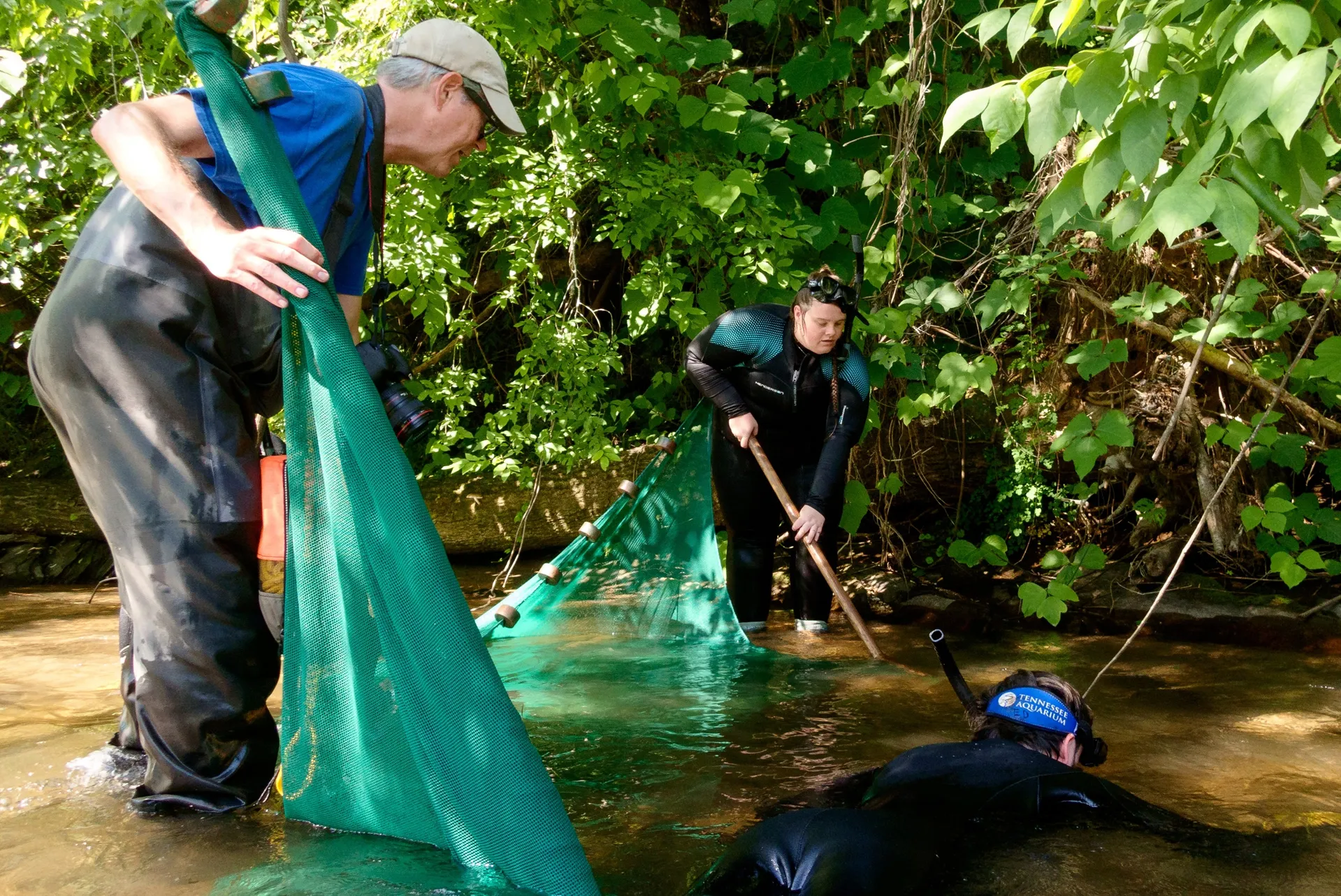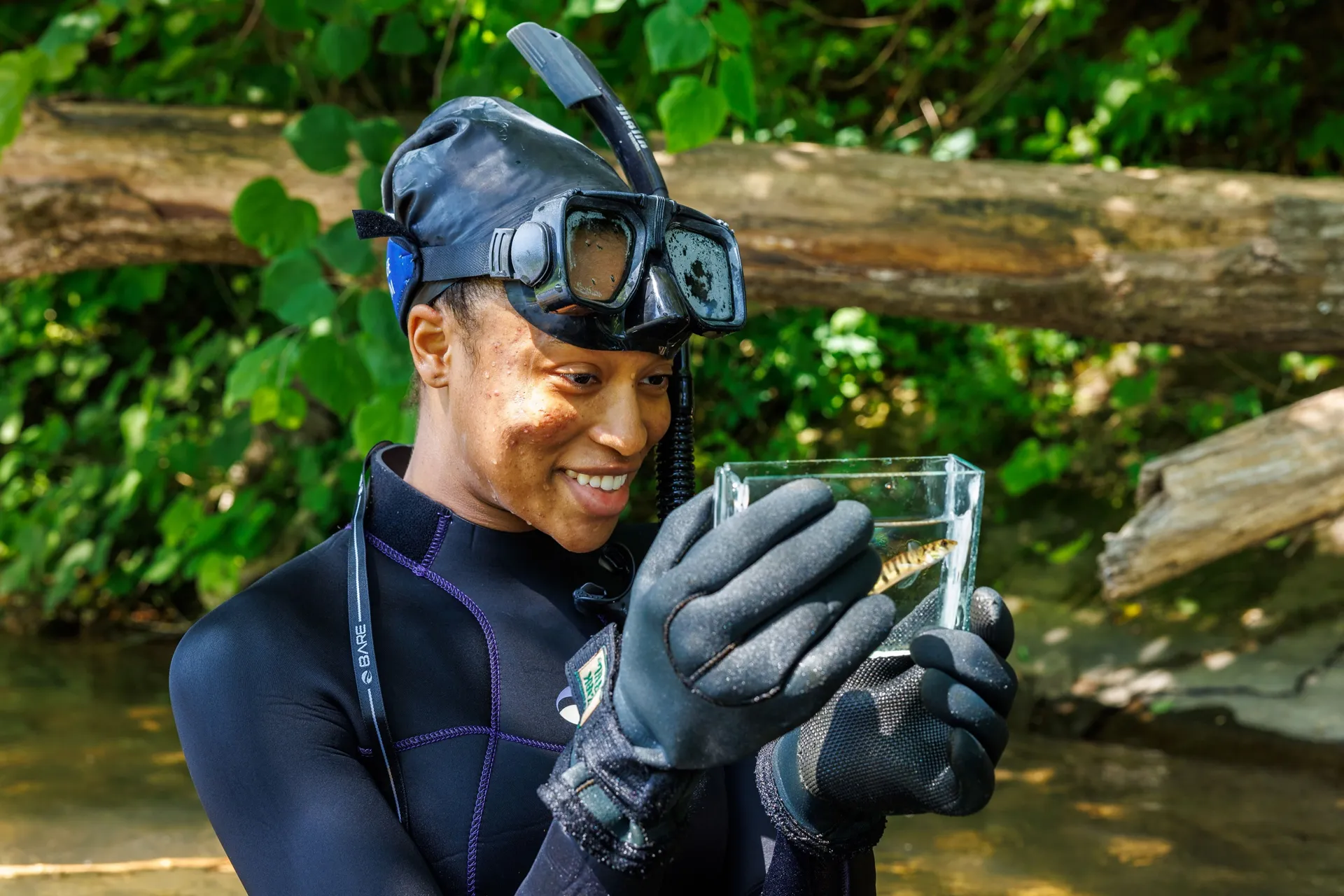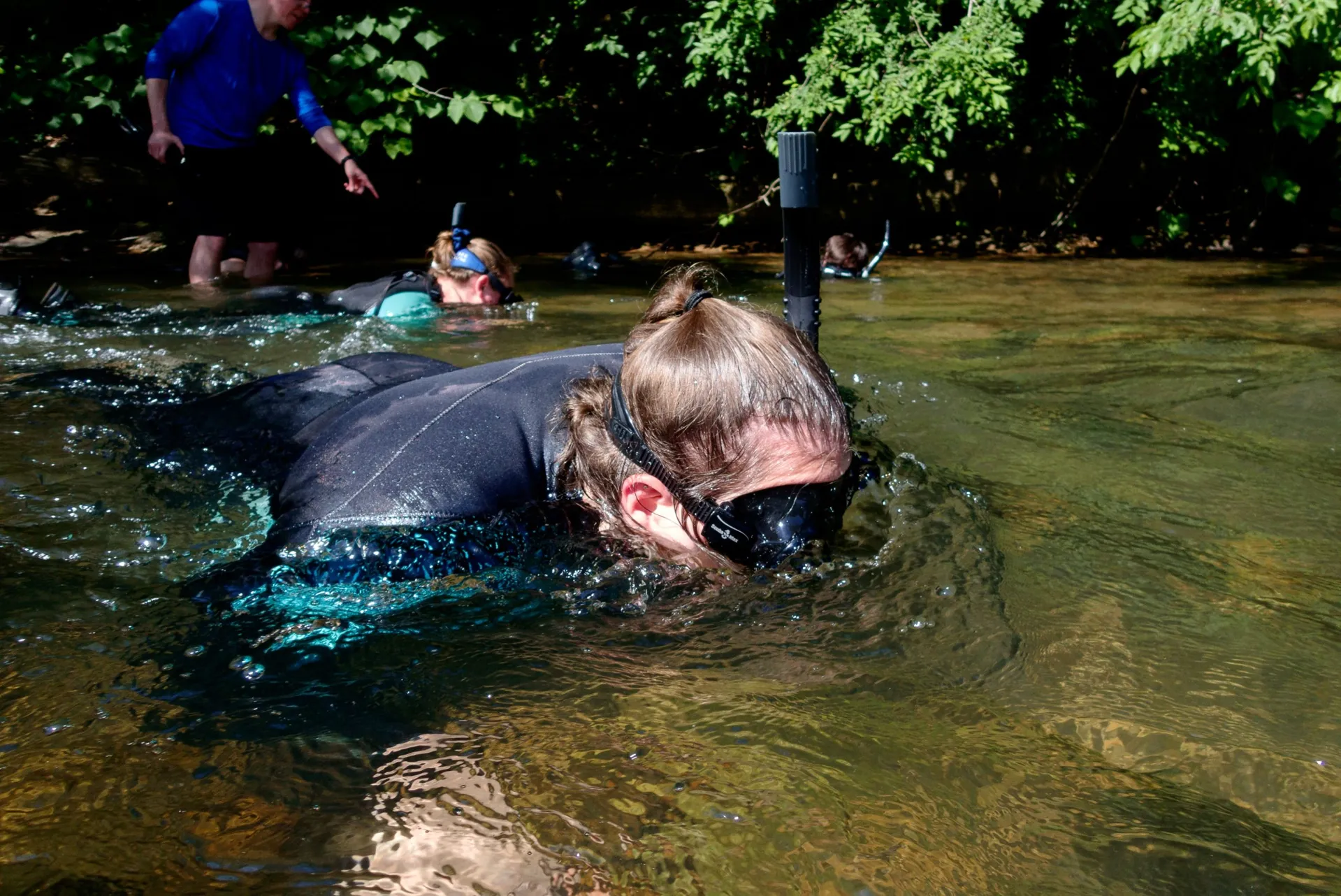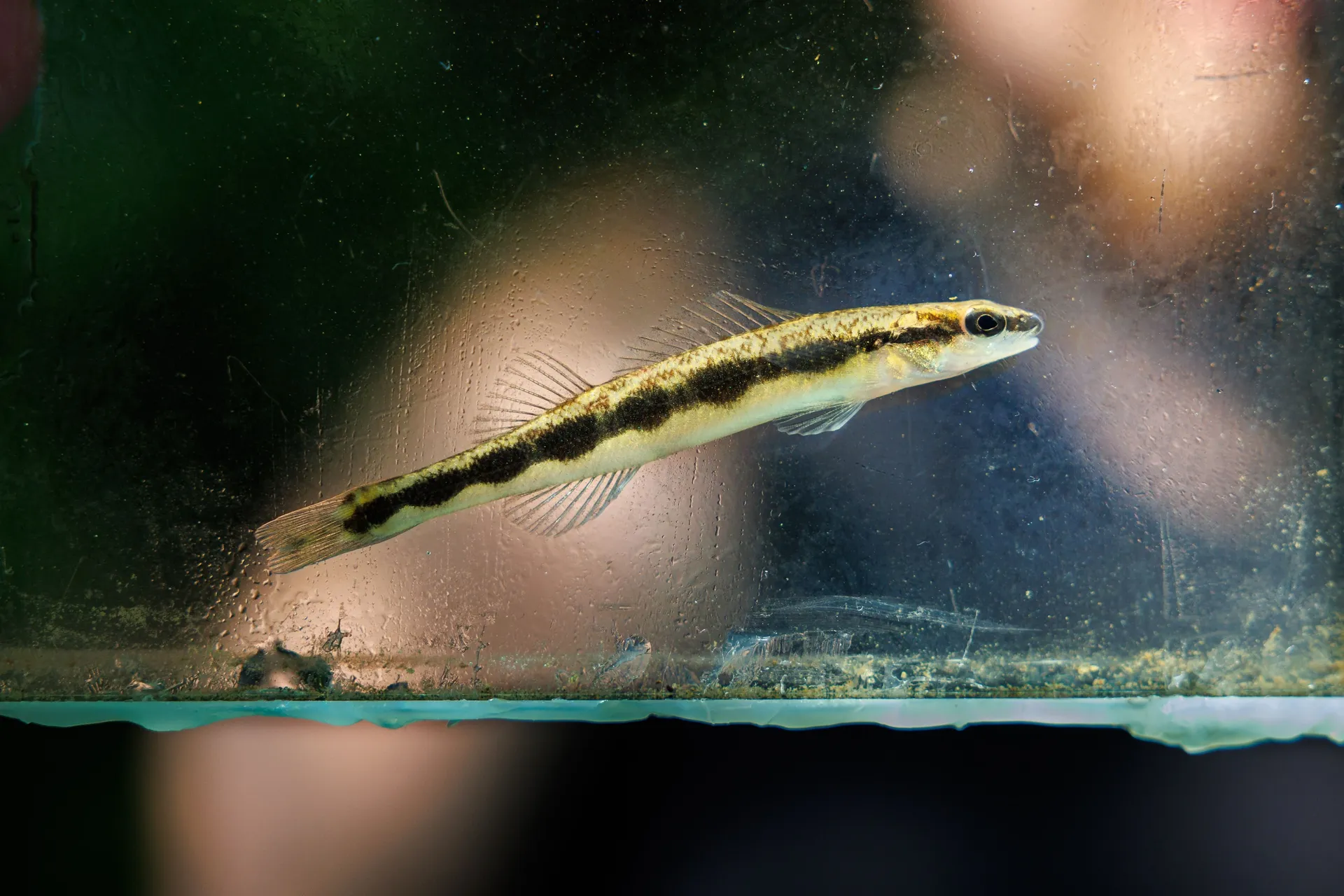During their summer break, most college students while away the time working shifts at a restaurant or manning a cash register, earning a paycheck, if not much else.
Squatting on his heels to dangle the flexible hose of an environmental DNA pump into a briskly flowing North Georgia stream, Spencer Trimpe’s summer has been anything but ordinary. With the pump’s droning motor steadily collecting a sample of water rife with genetic traces of the stream’s inhabitants, he doesn’t bother holding back a smile.
A lanky junior biology major from Thomas More University, Trimpe is one of two students selected as part of the George Benz Aquatic Ecology Fellowship to spend the summer working alongside freshwater scientists at the Tennessee Aquarium. The program is named for the Aquarium’s first chief research scientist and the founder of what eventually was renamed the Tennessee Aquarium Conservation Institute.
Instead of the minimum-wage summer grind many of his classmates are enduring, Trimpe is using cutting-edge equipment to search for genetic signals that indicate the presence in the stream of the Etowah Bridled Darter.
“This is one of the most amazing experiences I’ve ever had,” Trimpe says. “It’s a great opportunity to gain experience with all the amazing conservationists who work here and to get outside and see what’s in this stream.”
Out Of Class, In The Field
Trimpe is part of a team of freshwater scientists, graduate students and other Aquarium fellows methodically working their way through Long Swamp Creek, an unassuming tributary of the Etowah River flowing past Jasper, Georgia about 50 miles north of Atlanta.
In addition to looking for genetic traces of Etowah Bridled Darters in this waterway, the team also is taking a more active approach to locating their quarry. Camera cases, buckets and floating seine nets line the stream banks, and almost every member of the team is wearing a wetsuit, facemask and snorkel. In fact, the majority of the crew’s time is spent sprawled, face down in the water, army crawling over submerged boulders and through riffles on the lookout for quicksilver flashes of brown and gold.
For this field outing, Trimpe is joined by two other Aquarium fellows: Ethan Dodson, a senior fisheries and wildlife biology student from Arkansas Tech University, and Breelyn Bigbee, a wildlife, fisheries and aquaculture major from Mississippi State University.
Dodson is this summer’s second George Benz fellow. Bigbee is one of seven applicants selected for the Aquarium’s 11-week Jim Hill Fellowship, a second paid program designed to provide opportunities for minority college students pursuing a science or education degree. Jim Hill selectees spend their summer filling specific roles at the Aquarium, with some specializing in conservation or husbandry while other focus on education or operations.


The benefits of these programs are numerous and flow in both directions, says Mara-Lynne Payne, the Aquarium’s senior manager of inclusion, equity and inclusion.
“The Jim Hill Diversity Fellowship program, in particular, allows us to recruit and connect with students who have been historically underrepresented in the conservation science, animal care, and science education fields,” Payne says. “We need diverse perspectives and diverse representation in order to make the greatest impact.
“When we speak of inspiring the next generation of environmental stewards, these types of fellowship programs give us the greatest opportunities to do that. For the students, they get to work alongside our staff and gain hands-on experiences that they may not have considered or even imagined.”
Helping Hands
This summer, Simpe, Bigbee and Dodson are all working under the watchful eyes – and are subjected to the frequent, often-groan-inducing fish jokes – of Aquatic Conservation Biologist Dr. Bernie Kuhajda and Recovery Biologist Shawna Fix.
The lone wetsuit-less participant in the sampling on Long Swamp Creek, Kuhajda stands sentry with a seine net, waiting for a signal that the snorkelers have located a Bridled Darter and are ready to herd it to him for collection. Trying to corral such an elusive species requires the participation of many if there’s going to be any chance of success, he says.
“We love the Jim Hill and George Benz fellowships,” Kuhajda says. “We literally could not complete many of the grant-funded projects we’re working on without help from our fellows.
“These kids get to come out and collect fishes, assess fish passage through culverts, measure microhabitats and compare population health. They get all these different experiences of what it means to be a fish biologist, particularly a fish conservation biologist. Hopefully, that excites them to go on to become freshwater scientists.”
When we speak of inspiring the next generation of environmental stewards, these types of fellowship programs give us the greatest opportunities to do that.
Mara-Lynne Payne — Senior Manager of Inclusion, Equity and Inclusion
In a kind of generational passing of the scientific torch, two past Aquarium fellows were part of the day’s search for Etowah Bridled Darters: David Pounders (George Benz fellow) and Mason Strickland (Jim Hill fellow). Pounders and Strickland worked alongside Kuhajda and Fix in the summer of 2021 and are now pursuing graduate studies at the University of West Alabama.
It was during her tenure at the Tennessee Aquarium Conservation Institute that Strickland first began studying the Bridled Darter, which scientists determined earlier that year to comprise two genetically distinct species, the Bridled Darter and Etowah Bridled Darter.
The Bridled Darter, which was only known to live in the Etowah River and Conasauga River, was already listed as state-endangered in Tennessee. Splintering off the Etowah River group as a separate species dramatically restricted the range of the Bridled Darter and the Etowah Bridled Darter, alike. This spurred researchers to re-evaluate the distribution and health of both species to determine whether one or both warranted listing as endangered.
During the course of three days sampling for Etowah Bridled Darters at two locations on the Etowah River, Pounders, Strickland and the Aquarium team collected 25 individuals, including 17 at Long Swamp Creek alone. Previous sampling efforts for Etowah Bridled Darters at this site by the Georgia Department of Natural Resources in 2016 and 2017 found just four individuals.


When she began her graduate studies this year, Strickland found herself in a position to carry on the work she started with the Etowah Bridled Darter at the Aquarium alongside her advisor, Dr. Mike Sandell, an assistant professor of zoology and the coordinator of conservation programs at the University of West Alabama.
“He was working on this project in his lab for the genetic portion, so I was able to pick it up as my thesis,” Strickland says.
But interest in the Bridled Darter wasn’t her only takeaway from the time she spent as an Aquarium fellow.
“I love working with Bernie and Shawna. They’ve been huge mentors in the field for me,” she says. “They’re why I wanted to get into his work and why I got so lucky to go to grad school to work with a fish that I’m really passionate about.”
Next Generation Scientists
Whether or not the Bridled Darter and Etowah Bridled Darter eventually become listed as endangered, freshwater conservation science is a field that often requires projects to be undertaken with an expectation that success or progress may be years or decades over the horizon. In that sense, it’s imperative that programs like the Jim Hill and George Benz fellowships exist to connect field researchers with up-and-coming students like Trimpe, Dodson and Bigbee, who may someday carry their work forward.
“Science is a relay race,” Kuhajda says. “It can take decades and decades to recover some streams that have become really degraded or to pull a species back from the brink of extinction. You just have to make a long-term commitment.
“There is a mountain of work to do out there. It’s huge, but we’re chipping away at it and making pretty good progress with all the wonderful fellows we have and all the graduate students we collaborate with.”
The Jim Hill Fellowship and George Benz Fellowship are offered every summer. Applications for the program will next be accepted in spring of 2023.
For more information about these and other opportunities to study or work at the Aquarium, visit tnaqua.applicantpro.com/jobs/